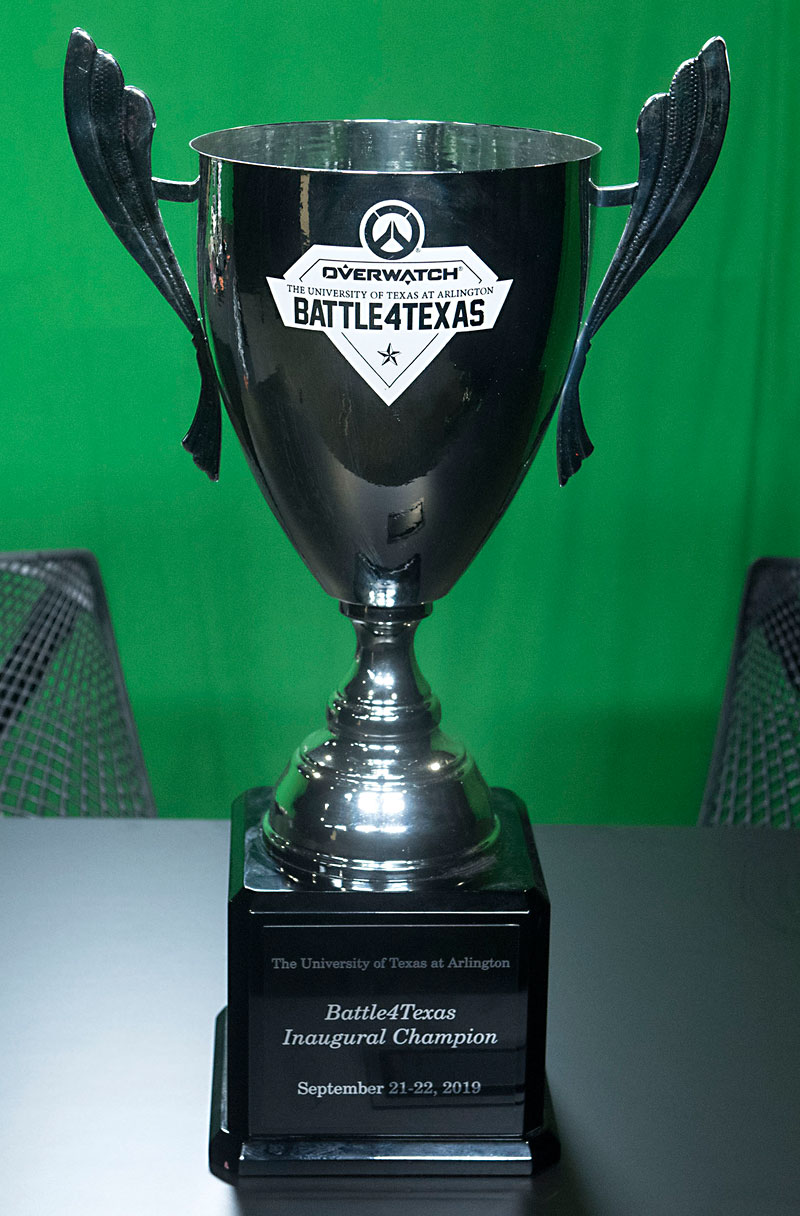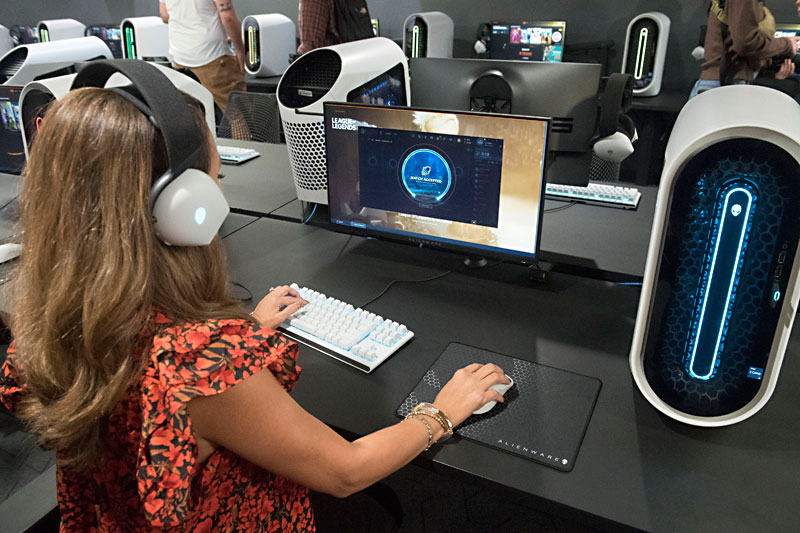UT-Austin’s Esports Level Up
A new state-of-the-art gaming arena creates a space for all students
By Derek Udensi, Fri., Nov. 17, 2023

There's still plenty of bowling and billiards available at the Texas Union Underground, but a new eye-catching space, branded the Alienware Longhorn Esports Arena, glows in its lowest level. Surrounded by 30-plus elite Alienware gaming desktop stations and multiple televisions inside of the impressive space, Esports Student Program Coordinator for University Unions Austin Espinoza uses an Xbox as he prepares the arena to host its first class. The lesson? Instruction of medieval literature through role-playing video game The Elder Scrolls V: Skyrim.
A ribbon-cutting ceremony for the Alienware Longhorn Esports Arena occurred on Oct. 11, a year after the opening of its partner lounge, with its 10 Alienware Aurora R13 gaming desktop stations in a can't-miss miss spot on the Union's second floor. Both facilities indicate UT-Austin's significant investment into not only collegiate esports (the term for competitive video gaming), but gaming as a whole. It's a complete 180-degree pivot from when Espinoza led Longhorn Gaming, the premier gaming-focused student organization on the Forty Acres. While president, he tirelessly advocated for the university to build a dedicated space. Incidents such as a West Campus power outage that effectively ruined LG's chances of qualifying for the 2019 College League of Legends Championship Finals vindicated his efforts. After graduating in 2020, Espinoza returned to campus last year to become UT's first-ever full-time esports employee. Now that two spaces exist on campus, his passion to establish an inclusive, wide-ranging gaming culture beams brighter than ever.
"I think our best move forward is completely unifying gaming on campus as best as we can through our spaces and events and getting everybody to recognize how much it's been normalized to be a part of the gaming community," he said.
Longhorn Gaming became a sponsored student organization (SSO) through University Unions during the fall 2021 semester after previously receiving support from the College of Fine Arts. That sponsorship provides a slew of resources, such as seamless rental to LG of various buildings under the Unions umbrella, on top of financial assistance. Espinoza praised how University Unions and Longhorn Gaming are combining forces to get "more attention for gaming as a whole. I love hearing people walk by [and say], 'Holy crap.' Seeing how many people are walking in from staring, it's so good."
For James Buckley, director of facilities and operations at University Unions, the need to heavily invest in gaming became evident for multiple reasons, not least the lack of a central hub on campus and a hunger from and for gamers to connect in person after the coronavirus pandemic.
"With the lounge first [we can say]: 'Hey, here's a place to come and gather and see people in person and play,'" Buckley said. "Have stable internet, have a gaming system that you can't afford at home that is available to you. That ability to bring people together, create community, let them develop networks, connections, and enhance their skills."
There was also realization that other institutions nationwide had already opened their own esports arenas. "Through our connections and networks around the country, it was becoming obvious to us that many other schools were already ahead of us," Buckley added. "They already had esports facilities, lounges, and arenas on their campus and, oftentimes, in their college unions on their respective campuses. It's not often that UT is behind in the race, but we realized other schools – a lot of our peer institutions – are out in front of us. We've got to play catch-up, but we don't want to just play catch-up. We want to do it the UT way and make UT proud and our students proud."
Espinoza noted that at 3,400-square feet, the Alienware Longhorn Esports Arena is currently the largest dedicated gaming and esports space at a Texas university. And unlike most universities, UT-Austin has more than one facility and intends to operate both the lounge and the arena simultaneously for the foreseeable future. Alienware and UT officials initially envisioned the lounge serving as a pop-up of sorts while the arena was under construction, but the lounge quickly proved a rousing success as students clamored for more space. "I love that location and all the windows around it – it's a beautiful spot," Director of Global Gaming Campaigns at Dell Chris Saylor said. "After we built this thing and we started seeing how people were responding to it on the ground floor and how much traction it was getting, we were like, we should keep this. UT agreed."
Alienware's grassroots, hands-on involvement in the design and development of both UT spaces marks the gaming brand's flagship entry into collegiate esports. The Dell subsidiary hopes to open esports spaces at five other universities within the next year. Saylor echoed Espinoza's and Buckley's sentiments regarding UT's esports spaces fostering community and professional development for students. "We believe in esports as an industry and the power of college as a place to cultivate the next talent coming into the esports industry," he said. "These programs are less about cultivating the pro gamer talent and more about the esports industry overall and the culture around it. The industry is becoming more legitimized, and as it's growing, there are more jobs in esports organizations."
Though anyone with a valid UT ID can reserve time at the lounge and arena, Longhorn Gaming's esports teams have exclusive access to a room labeled "varsity" inside the arena. Decked with eight highest-echelon Alienware Aurora R16 gaming desktop stations and a 76-inch television, LG's competitive members can finally compete and practice in person together over a reliable internet connection. Mathematics senior Jack Alberts, who currently leads Longhorn Gaming as its president, noted that there are about 2,500 active students on LG's Discord servers, and a similar number have visited the lounge. "That's like 5% of undergrads," he said, adding that he believes the arena can take LG's competitive teams "to the next level."
"I want our esports teams to grow," he said, "and I'd love to be highly ranked in the country. But I also want [to tap] into that other side – the more casual gamers. I'm most certainly not the best at video games even though I have a very competitive spirit. So I want to tap into that side – and that's a whole lot bigger."
The united focus on embracing competitive and casual gaming has drawn positive results. That balanced approach allows a professor to teach in an esports arena three days after a Halloween weekend Genshin Impact event that garnered over 150 registrants. Still, Longhorn Gaming noticeably refers to its organization as such instead of something along the lines of "University of Texas at Austin Esports" because UT hasn't made esports an official varsity program. Not yet, at least. Buckley theorizes that move may possibly happen organically down the line as Longhorn Gaming continues to blossom, but he currently harbors more focus toward the spaces' potential to complement what students learn in the classroom. His primary driver remains maintaining welcoming community spaces that "are as good as [they can] make it" from a technological and facility standpoint. He likens the competitive nature of the collegiate world to an arms race in which technological advancements can quickly turn "state of the art" into "outdated."
So with true burnt orange confidence, he defines what type of statement the Alienware Longhorn Esports Arena lays down: "UT is here in the world of collegiate esports and we will stack up with the best – with the goal to be the best."

Bit by Bit: UT Esports by the Numbers
$0: Cost of membership and cost to use the console gaming area (must have valid UT ID or be present with someone who has a valid UT ID)
4,000+: Members on the Longhorn Gaming Discord (2,500+ are active students, according to Alberts)
14: Video games for which the organization currently fields at least one team
2,000: UT IDs scanned in to use the lounge during its first year, according to Espinoza
12: Gaming consoles available in the arena (Xbox, PlayStation 5, & Nintendo Switch systems)
43: Total number of gaming desktop stations in the arena
150: Number of registrants for the Oct. 27 Genshin Impact event










